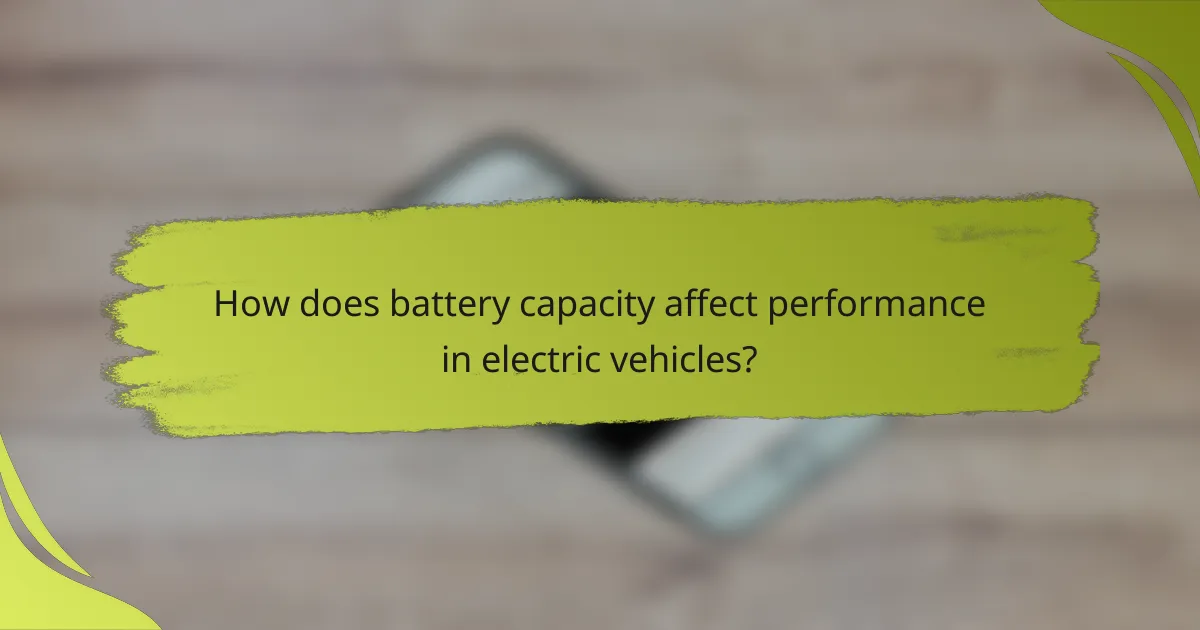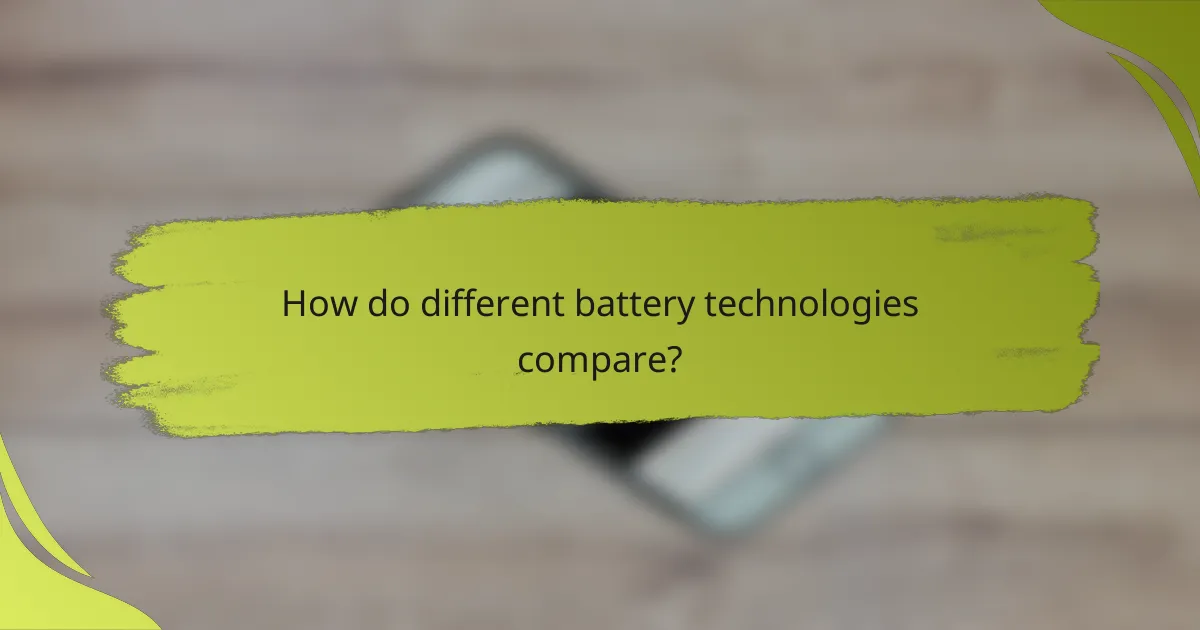Understanding battery life is crucial for maximizing the performance of various devices, from smartphones to electric vehicles and laptops. Several factors, including battery capacity, hardware efficiency, and user habits, play significant roles in determining how long a device can operate between charges. By adopting effective practices and being mindful of power management, users can significantly enhance their device’s battery longevity.

What are the best practices for extending battery life in smartphones?
To extend battery life in smartphones, users should adopt several effective practices that minimize power consumption. These strategies can significantly enhance battery longevity, allowing for longer usage between charges.
Optimize screen brightness
Adjusting screen brightness is one of the most impactful ways to conserve battery life. Keeping brightness at a lower level, or using adaptive brightness settings, can reduce power usage by up to 30% in some cases.
Consider setting your brightness to around 50% for regular use, and lower it further in dim environments. Many smartphones also offer an automatic brightness feature that adjusts based on ambient light, which can help maintain battery efficiency.
Limit background app activity
Background apps can drain battery life by continuously using resources. Limiting the number of apps running in the background can help preserve energy and extend battery life.
Check your smartphone’s settings to identify which apps are consuming the most battery and restrict their background activity. You can also close apps that are not in use, which can save additional power.
Use battery saver mode
Activating battery saver mode can significantly enhance battery longevity by reducing performance and limiting background processes. This feature is designed to maximize battery life when it is running low.
Most smartphones allow users to customize battery saver settings, such as reducing screen brightness and disabling non-essential notifications. Engaging this mode when battery levels drop below 20% can help you get through the day without needing a charge.
Update software regularly
Keeping your smartphone’s software up to date is crucial for optimal battery performance. Software updates often include improvements that enhance battery efficiency and fix bugs that may drain power.
Regularly check for updates in your device settings and install them promptly. This practice not only helps in extending battery life but also ensures that your device runs smoothly and securely.
Disable unnecessary features
Disabling features that are not in use can help conserve battery life. Functions such as Bluetooth, GPS, and Wi-Fi can consume significant power when active, even if you are not using them.
Turn off these features when they are not needed, and consider using airplane mode in low-signal areas to prevent your phone from continuously searching for a signal. This simple action can lead to noticeable battery savings over time.

How does battery capacity affect performance in electric vehicles?
Battery capacity directly influences the performance of electric vehicles (EVs) by determining how much energy can be stored and used for driving. A higher capacity typically means a longer driving range, allowing for more extended use between charges.
Higher capacity leads to longer range
A larger battery capacity enables an electric vehicle to travel further on a single charge. For instance, EVs with capacities around 60-100 kWh can often achieve ranges of 200-400 kilometers, depending on driving conditions and efficiency. This extended range reduces the frequency of charging stops, making long trips more feasible.
However, higher capacity batteries can also add weight to the vehicle, which may slightly impact overall efficiency. It’s essential to balance battery size with vehicle design to optimize performance and range.
Battery chemistry impacts charging speed
The chemistry of the battery significantly affects how quickly it can be charged. Lithium-ion batteries, commonly used in EVs, can typically charge at rates of 50-150 kW, allowing for rapid charging in about 30 minutes at high-power stations. In contrast, older battery technologies may charge much slower, taking several hours.
When selecting an electric vehicle, consider both the battery capacity and the type of battery chemistry. Some models offer fast-charging capabilities, which can be a crucial factor for users needing quick turnaround times during travel.

What factors influence battery life in laptops?
Battery life in laptops is primarily influenced by hardware components, usage habits, and power management settings. Key factors include the efficiency of the processor, the display’s resolution and size, and the power settings configured by the user.
Processor efficiency
The processor’s efficiency plays a crucial role in determining battery life. Modern processors often feature power-saving modes that reduce energy consumption during less demanding tasks. For instance, a laptop with a low-power processor can extend battery life significantly compared to one with a high-performance chip.
When selecting a laptop, consider processors labeled as energy-efficient, such as Intel’s U-series or AMD’s Ryzen U-series. These processors can help achieve longer battery life, especially during everyday tasks like browsing or document editing.
Display resolution and size
The display’s resolution and size directly impact battery consumption. Higher resolutions, such as 4K, require more power to operate, leading to shorter battery life. Conversely, a lower resolution display may consume less energy, making it a better choice for users prioritizing battery longevity.
Additionally, larger screens typically use more power than smaller ones. If portability and battery life are essential, opting for a laptop with a smaller, lower-resolution display can be beneficial.
Power settings and usage patterns
Power settings and usage patterns significantly affect battery life. Adjusting settings such as screen brightness, sleep mode, and background applications can lead to substantial energy savings. For example, lowering screen brightness by even a small amount can extend battery life by several hours.
Users should also be mindful of their usage patterns. Activities like gaming or video editing demand more power, draining the battery faster. To maximize battery life, consider using power-saving modes during less intensive tasks and closing unnecessary applications when not in use.

What are the common misconceptions about battery life?
Many people hold misconceptions about battery life that can lead to poor maintenance and reduced performance. Understanding these myths can help users maximize their battery longevity and efficiency.
Charging overnight damages the battery
Charging a device overnight does not inherently damage the battery. Modern smartphones and laptops are equipped with smart charging technology that stops charging once the battery reaches 100%, preventing overcharging.
However, keeping a device plugged in for extended periods can lead to heat buildup, which may degrade battery health over time. To mitigate this, consider using a charger that automatically adjusts power based on battery needs.
All batteries need to be fully discharged
It is a common myth that batteries need to be fully discharged before recharging. In fact, lithium-ion batteries, which are used in most modern devices, perform better when kept between 20% and 80% charge.
Regularly allowing the battery to drop to very low levels can lead to a shorter lifespan. Instead, aim to recharge your device when it reaches around 30% to maintain optimal battery health.

How do temperature and environment affect battery performance?
Temperature and environmental conditions significantly impact battery performance and lifespan. Extreme heat can accelerate degradation, while cold temperatures may hinder efficiency, affecting how well a battery functions in various situations.
Extreme heat reduces battery lifespan
High temperatures can lead to increased chemical reactions within a battery, which can shorten its lifespan. For lithium-ion batteries, prolonged exposure to temperatures above 30°C (86°F) can result in a noticeable decline in capacity over time.
To mitigate heat-related damage, avoid leaving batteries in hot environments, such as inside a car during summer. Instead, store them in cooler, shaded areas to help maintain optimal performance.
Cold temperatures can decrease efficiency
Cold weather can reduce a battery’s efficiency, making it less effective at delivering power. Lithium-ion batteries may experience a drop in capacity when temperatures fall below 0°C (32°F), leading to shorter usage times.
To counteract the effects of cold, keep devices warm when outdoors, such as in an inner pocket, and avoid using them in extremely low temperatures. This can help maintain battery performance and extend its usability in chilly conditions.

What role does battery management software play?
Battery management software is crucial for maintaining optimal battery performance and longevity. It monitors various parameters, ensuring the battery operates within safe limits and enhancing overall efficiency.
Monitors battery health
Battery management software continuously tracks the health of the battery, assessing factors like charge cycles, temperature, and voltage levels. By analyzing this data, the software can predict potential issues, allowing users to take preventive measures before significant degradation occurs.
For example, if the software detects that the battery is frequently overheating, it may recommend reducing usage or adjusting charging habits. Regular monitoring can extend battery life by identifying problems early, which is particularly important for devices that rely heavily on battery power.
Optimizes charging cycles
Effective battery management software optimizes charging cycles to maximize efficiency and lifespan. It adjusts the charging rate based on the battery’s current state, helping to prevent overcharging and excessive depletion.
Many systems implement algorithms that slow down charging as the battery nears full capacity, which can reduce wear and tear. Users can benefit from features like scheduled charging, allowing them to charge during off-peak hours to save on electricity costs while ensuring their device is ready when needed.

How do different battery technologies compare?
Battery technologies vary significantly in terms of performance, longevity, and application suitability. Understanding these differences helps consumers and businesses choose the right battery for their needs.
Lithium-ion batteries
Lithium-ion batteries are widely used in consumer electronics and electric vehicles due to their high energy density and relatively low self-discharge rates. They typically offer a lifespan of around 2 to 10 years, depending on usage and charging habits.
These batteries can charge quickly, often reaching 80% capacity in under an hour. However, they can be sensitive to temperature extremes, which may affect their performance and longevity.
Nickel-metal hydride batteries
Nickel-metal hydride (NiMH) batteries are commonly found in hybrid vehicles and rechargeable household products. They have a lower energy density compared to lithium-ion but are more robust in terms of temperature tolerance.
NiMH batteries generally last about 3 to 5 years. They are less prone to overheating and can handle higher discharge rates, making them suitable for applications requiring quick bursts of energy.
Lead-acid batteries
Lead-acid batteries are often used in automotive applications and uninterruptible power supplies (UPS) due to their low cost and reliability. They typically have a lifespan of 3 to 5 years, but their energy density is significantly lower than that of lithium-ion or NiMH batteries.
These batteries are heavy and require regular maintenance, including checking electrolyte levels. Despite their drawbacks, they are still favored for their robustness and ability to deliver high surge currents.
Solid-state batteries
Solid-state batteries represent an emerging technology that promises higher energy densities and improved safety compared to traditional lithium-ion batteries. They use a solid electrolyte instead of a liquid one, which reduces the risk of leaks and fires.
While still in development, solid-state batteries could potentially last longer and charge faster than current technologies. However, they are currently more expensive to produce, which limits their widespread adoption.
